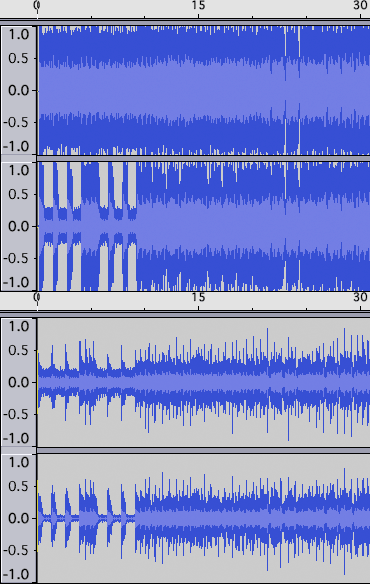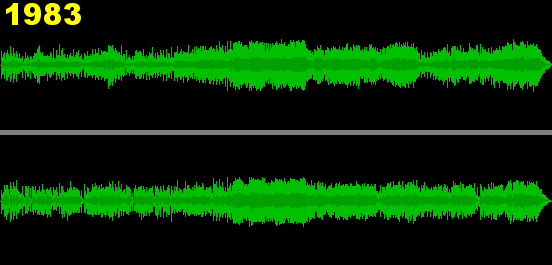The level of recorded music just keeps on increasing. This is what the music press and concerned fans refer to as the “loudness war”. Since digital audio has an absolute upper level limit, it is therefore unavoidable that the dynamic range suffers. This has been going on since the early 90's, resulting in the small differences between the weak and the loud parts which is so common in today’s music.
But does that mean that the music actually sounds worse? This is what Danish researchers at Copenhagen University Hospital, the Technical University of Denmark, and Aalborg University recently tested.
 Just look at at the 30 second plot of the waveform from Metallica's "My Apocalypse". On top is the trace of the heavily processed CD version and below is the much weaker version from Guitar Hero. Also notice how small the differences are between the loudest and the weakest parts in the CD version after the first 10 seconds.
Just look at at the 30 second plot of the waveform from Metallica's "My Apocalypse". On top is the trace of the heavily processed CD version and below is the much weaker version from Guitar Hero. Also notice how small the differences are between the loudest and the weakest parts in the CD version after the first 10 seconds.
Journalist Jan Omdahl in the Norwegian daily Dagbladet describes it like this: "With only three to four decibels of variation between the loudest and the weakest signal, we are talking about an album that sonically has crashed into a brick wall at 200 km/h."
 The much softer "Something" by the Beatles shows the same trend when 3 minute long versions from 1983
to 2000 are compared. It is as if drum beats and the rhythm of the bass are
completely squashed. This is often described as loss of depth and spaciousness,
that the music is flat and squashed, and that the instruments mush into each other.
The much softer "Something" by the Beatles shows the same trend when 3 minute long versions from 1983
to 2000 are compared. It is as if drum beats and the rhythm of the bass are
completely squashed. This is often described as loss of depth and spaciousness,
that the music is flat and squashed, and that the instruments mush into each other.
Others say it sounds unmusical, and that in the long run it will create listener fatigue. Journalist Geir Nordby goes so far as to recommend that "When an old record is re-released in a remastered edition, and you need it in your collection, buy the original version instead."
It can all be blamed on the multi-band compressors, brimming with signal processing as they are. There’s no doubt about their purpose when the manufacturers have given them unambiguous names like Ultramaximizer and Finalizer. The compressors have just gotten better and better over the years and the music industry seems to have few objections to using them to squash the dynamics.
Danish researchers have now investigated this. They did not compare plots like I have done above, but used panels of listeners that compared 15 original tracks with 15 new releases. Many of the examples were songs that had been criticized for inferior sound quality in the re-release. Among the examples were Aha, "Hunting High and Low", Dire Straits "Money for Nothing" and U2 "I Still Haven’t Found". The panels of listeners were not informed about the purpose of the experiment as they compared 15-second excerpts of songs. They were also very careful that all the clips should have vocal sound. I assume that this is because we all have a very clear idea of how a lifelike voice should sound.
Surprisingly enough, they found no clear preference for neither the original nor the compressed version, except in one instance and that was Metallica "Broken, Beat, Scared." This was the clip that had the greatest degree of reduction in dynamics (ratio between the peak value and average) as it was decreased by 8.7 dB in the CD version compared to the Guitar Hero version. In other songs, the reduction was between 2.3 and 7.1 dB, but this seemed not to be very audible. They also believe that the reason that the Metallica clip was judged to sound inferior might just as well be that the signal had been clipped as that the dynamics had been reduced. Clipping is clearly an undesirable effect that creates distortion.
The loudness war started with FM stations in the 80's. FM modulation is similar to digital sound in the sense that there is a hard upper limit for how much one can turn up the modulation. Otherwise neighboring stations will interfere with each other. But it is well known in psychoacoustics that the louder the signal, the better the audio is perceived to be. Therefore in order to attract casual scanners of the FM band, loud level is desirable. Later this tendency spilled over into the mastering of CD's.
But compressed dynamics is not without benefits. With the advent of portable players music became ubiquitous. You can listen to it in the street and on the train as well as in the car. Then it may be an advantage with little dynamics in order for the music to stand out from the background noise. Compressed dynamics with its punch and impact also has a lot in common with the Wall of Sound signature of Phil Spector that is so popular today.
The result of the listening test is definitely surprising and it gives rise to many new questions that would be interesting to investigate further. It may for instance be a problem that only 15 second clips were compared. On the one hand it is difficult to remember the reference if a clip is much longer than this. On the other hand there are many who believe that listening fatigue and the other alleged effects of the loudness war require much longer excerpts to be heard.
One can start wondering if all the talk about flat and squashed sound that lacks depth and spaciousness really describes listening impressions. Or have we been deceived by our eyes and have been too busy staring at the plots instead of listening with our ears?
- Jens Hjortkjær and Mads Walther-Hansen. «Perceptual Effects of Dynamic Range Compression in Popular Music Recordings.» Journal of the Audio Engineering Society 62.1/2 (2014): 37-41.
- Wikipedia: Waveform of song «My Apocalypse» by Metallica by User Stormwatch and Waveform image of «Something» by The Beatles by User Aquegg




Comments